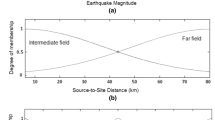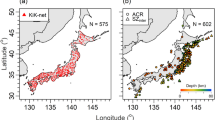Abstract
The recent earthquakes caused severe damages on the existing buildings. By this motivation, an important amount of research work has been conducted to determine the seismic risk of seismically active regions. For an accurate seismic risk assessment, processing of ground motions would provide an advantage. Using the current technology, it is not possible to precisely predict the future earthquakes. Therefore, most of the current seismic risk assessment methodologies are based on statistical evaluation by using recurrence and magnitude of the earthquakes hit the specified region. Because of the limited number of records on earthquakes, the quality of definitions is questionable. Fuzzy logic algorithm can be used to improve the quality of the definition. In the present study, ground motion data profile of western Turkey is defined using an intelligent hybrid processing. The approach is given in a practical way for an easier and faster calculation. Earthquake data between 1970 and 1999 from western part of Turkey have been used for training. The results are tested and validated with the earthquake data between 2000 and 2015 of the same region. Enough approximation was validated between calculated values and the earthquake data by using the intelligent hybrid processing.













Similar content being viewed by others
References
Adeli, H., & Panakkat, A. (2009). A probabilistic neural network for earthquake magnitude prediction. Neural Networks, 22(7), 1018–1024.
Akinci, A., Eyidogan, H., Gokturkler, G., Akyol, N., & Ankaya, O. (2000). Investigation of the seismic activity and seismic hazard of Izmir city and its vicinity. In: Proceedings of the Earthquake Risk Assessment of West Anatolian Symposium (p. 231).
Akinci, A., Malagnini, L., Herrmann, R. B., Pino, N. A., Scognamiglio, L., & Eyidogan, H. (2001). High-frequency ground motion in the Erzincan region, Turkey: Inferences from small earthquakes. Bulletin of the Seismological Society of America, 91, 1446–1455.
Akinci, A., Malagnini, L., Herrmann, R. B., Gok, R., & Sorensen, M. (2006). Ground motion scaling in the Marmara region, Turkey. Geophysical Journal International, 166, 635–651.
Albert, T. Y., Felix, S., & Dong, W. (1993). A neural networks based MMI attenuation model. National Earthquake Conference, USA.
Ambraseys, N. N., Douglas, J., Sarma, S. K., & Smit, P. M. (2005). Equations for the estimation of strong ground motions from shallow crustal earthquakes using data from Europe and the Middle East: Horizontal peak ground acceleration and spectral acceleration. Bulletin of Earthquake Engineering, 3, 1–53.
Bommer, J. J. (2003). Uncertainty about the uncertainty in seismic hazard analysis. Opinion paper. Engineering Geology, 70, 165–168.
Bommer, J. J., Scherbaum, F., Fabrice, C., Bungum, H., & Sabett, F. (2004). Discussion on ‘Uncertainty Analysis of Strong-Motion and Seismic Hazard’ R. Sigbjörnsson and N. N. Ambraseys. Bulletin of Earthquake Engineering, 2, 261–267.
Bozkurt, S. B., Stein, R. S., & Toda, S. (2007). Forecasting Probabilistic seismic shaking for greater Tokyo from 400 years of intensity observations. Earthquake Spectra, 23(3), 525–546.
Bruneau, M. (2002). Building damage from the Marmara, Turkey earthquake of August 17, 1999. Journal of Seismology, 6(357–377), 2002.
Cai, Z. (2008). A continuous crustal stress monitoring method for earthquake prediction. Pure and Applied Geophysics, 165, 1879–1889.
Chandler, A. M., Chan, L. S., & Lam, N. T. K. (2001). Deterministic seismic hazard parameters and engineering risk implications for the Hong Kong region. Journal of Asian Earth Sciences, 20, 59–72.
Chen, D., Dong, W., & Shah, H. C. (1987). Earthquake reccurence relationships from fuzzy earthquake magnitudes. Soil Dynamics and Earthquake Engineering, 7(3), 136–142.
Cramer, C. H. (2001). A seismic hazard uncertainty analyses for the Madrid seismic zone. Engineering Geology, 62, 251–256.
Demicco, R., & Klir, G. (2004). Fuzzy logic in geology. London: Elsevier Academic Press.
Ellul, F., & D’ayala, D. (2003). The Bingöl, Turkey Earthquake of the 1st of May 2003. Field Report, Earthquake Engineering Field Investigation Team EEFIT, Architectural and Civil Engineering Dept., Univ. of Bath, Bath, UK.
Fedotov, S. A., Sobolev, G. A., Boldyrev, S. A., Gusev, A. A., Kondratenko, A. M., Potapova, O. V., et al. (1977). Statistical earthquake frequency analysis for Western Anatolia. Turkish Journal of Earth Sciences, 17, 741–762.
Feng, D. Y., Wu, G., Ichikava, M., & Ito, H. (1989). An application of the direct method of fuzzy pattern recognition to researchers of earthquake precursors in the Tokai area. Papers in Meteorology and Geophysics, 40(1), 1–19.
Feng, D. Y., Jiang C., Zheng, X., Lin M. Z., & Ito H. (1992). Applications of fuzzy neurol networks in earthquake prediction (pp. 809–812). International Conference on Information and Systems, China.
Firuzan, E., 2008. Statistical Earthquake Frequency Analysis for Western Anatolia. Turkish J. Earth Sci. 17, 741–762.
Google earth. (2015). Europa Technologies US Dept of State Geographer, Basarsoft, Teleatlas. http://www.googleearth.com.
Gulkan, P. (2000). Building code enforcement prospects: Failure of public policy, Chap. 15 of 1999 Kocaeli, Turkey. Earthquake Reconnaissance Report, Supplement A to Volume 16, Earthquake Spectra, December, vol 16 (pp. 351–367).
Gulkan, P., & Ergünay O. (1999). A perspective of disaster management in Turkey: Issues and prospects. In J. Ingleton (Ed.), Natural disaster management. London, UK: Tudor Rose.
Gulkan, P., & Kalkan, E. (2002). Attenuation modeling of recent earthquakes in Turkey. Journal of Seismology, 6, 397–409.
Gulkan, P., Ascheim, M., & Spence, R. (2002). Reinforced concrete frame building with masonry infills. WHE Report 64 (Turkey), World Housing Encyclopedia Earthquake Engineering Research Institute and International Association for Earthquake Engineering web page. (http://www.worldhousing.net).
Gullu, H., & Ercelebi, E. (2007). A neural network approach for attenuation relationships: An application using strong ground motion data from Turkey. Engineering Geology, 93, 65–81.
Gupta, I. D. (2002). The state of the art in seismic hazard analysis. ISET Journal of Earthquake Technology, 428(39), 311–346.
Halldorsson, B., & Papageorgiou, A. S. (2005). Calibration of the specific barriermodel to earthquakes of different tectonic regions. Bulletin of the Seismological Society of America, 95, 1276–1301.
Kagan, Y. Y. (1997). Statistical aspects of Parkfield earthquake sequence and Parkfield prediction experiment. Tectonophysics, 270(3–4), 207–219.
Kahraman, S., Baran, T., Saatci, I. A., & Salk, M. (2008). The effect of regional borders when using the Gutenberg–Richter model, case study: Western Anatolia. Pure and Applied Geophysics, 165(2), 331–347.
Klugel, J. U. (2005). Problems in the application of the SSHAC probability method for assessing earthquake hazards at Swiss nuclear power plants. Engineering Geology, 78, 285–307.
Kosko, B. (1992). Neural networks and fuzzy systems. Englewood Cliffs (NJ): Prentice Hall.
Kossobokov V. G. (2006). Testing earthquake prediction methods: ≪The West Pacific short-term forecast of earthquakes with magnitude MwHRV ≥ 5.8≫. Tectonophysics, 413(1–2), 25–31.
Krinitzsky, E. L. (2003). How to combine deterministic and probabilistic methods for assessing earthquake hazard. Engineering Geology, 70, 157–163.
Lasocki, S. (2000). Statistical estimation of the efficiency of earthquake prediction under uncertain identification of target events. Bulletin of the Seismological Society of America, 90(2), 324–333.
Leach, R., & Dowla, F. (1996). Earthquake early warning system using real-time signal processing. In Proc., Neural Networks for Signal Processing, Proc., 1996 IEEE Signal Proc., Society Workshop, Kyoto, Japan, September 4–6 (pp. 463–472).
Liu, Z. R., & Huang, C. F. (1990). Information distribution method relevant in fuzzy information analysis. Fuzzy Set and Systems, 36(1), 67–76.
Malagnini, L., Herrmann, R. B., & Koch, K. (2000). Regional ground motion in scaling in Central Europe. Bulletin of the Seismological Society of America, 90, 1052–1061.
Mirmomeni, M., Lucas, C., & Araabi, B. N. (2008). Using neurofuzzy models and spectral analysis for prediction of the exotic phenomena with catastrophic jumps, ICCSA 2008, Part I, LNCS 5072 (pp. 1156–1170).
Molchan, G. (1991). Structure of optimal strategies in earthquake prediction. Tectonophysics, 193(4), 267–276.
Molchan, G. M. (1997). earthquake prediction as a decision-making problem. Pure and Applied Geophysics, 149, 233–247.
Motazedian, D. (2006). Region-specific key seismic parameters for earthquakes in Northern Iran. Bulletin of the Seismological Society of America, 96, 1383–1395.
Nelson, S. A. (2004). Earthquake prediction and control. Tulane University EENS 204/Lecture Notes.
Ozcebe, G., Ramirez, J., Wasti, S. T., & Yakut, A. (2004) 1 May 2003 Bingöl earthquake engineering report. Rep. no. 2004/1, TÜBİTAK SERU Structural Engineering Research Unit, Ankara, Turkey.
Panakkat, A., & Adeli, H. (2007). Neural network models for earthquake magnitude prediction using multiple seismicity indicators. International Journal of Neural Systems, 17(1), 13–33.
Panakkat, A., & Adeli, H. (2008). Recent efforts in earthquake prediction: 1990–2007. Natural Hazards Review, 9(2).
Panakkat, A., & Adeli, H. (2008b). Recent efforts in earthquake prediction (1990–2007). Natural Hazards Review, 9(2), 70–80.
Panakkat, A., & Adeli, H. (2009). Recurrent neural network for approximate earthquake time and location prediction using multiple seismicity indicators. Computer-Aided Civil and Infrastructure Engineering, 24(4), 280–292.
Papadimitriou, E. (1994). Long term earthquake prediction in the north pacific zone based on the time and magnitude predictable model. Natural Hazards, 9, 303–321.
Papageorgiou, A. S., & Aki, K. A. (1983). specific barrier model for the quantitative description of inhomogeneous faulting and the prediction of strong ground motion, Part I: description of the model. Bulletin of the Seismological Society of America, 73, 693–722.
Peng, K., Yin, X., & Zhang, L. P. (2006). A statistical investigation of the earthquake predictions using LURR. Pure and Applied Geophysics, 163, 2353–2362.
Ramos, O. (2010). Criticality in earthquakes. Good or bad for prediction? Tectonophysics, 485(1–4), 1321–1326.
Raoof, M., Herrmann, R., & Malagnini, L. (1999). Attenuation and excitation of three-component ground motion in southern California. Bulletin of the Seismological Society of America, 89, 888–902.
Rikitake, T. (1969). An approach to prediction of magnitude and occurrence time of earthquakes. Tectonophysics, 8(2), 81–95.
Rikitake, T. (1988). Earthquake prediction: an empirical approach. Tectonophysics, 148(3–4), 1, 195–210.
Rydelek, P., & Pujol, J. (2004). Real-time seismic warning using a two-station sub-array. Bulletin of the Seismological Society of America, 94(4), 1546–1550.
Sen, Z. (1998). Fuzzy algorithm for estimation of solar irradiation from sunshine duration. Solar Energy, 63, 39–49.
Shebalin, P., Keilis-Borok, V., Gabrielov, A., Zaliapin, I., & Turcotte, D. (2006). Short-term earthquake prediction by reverse analysis of lithosphere dynamics. Tectonophysics, 413, 63–75.
Skyes, L., Shaw, B. E., & Scholz, C. H. (1999). Rethinking earthquake prediction. Pure and Applied Geophysics, 155, 207–232.
Sucuoglu, H. (2000). The 1999 Kocaeli and Düzce-Turkey earthquakes. Ankara: Middle East Technical University.
Uyeda, S., Nagao, T., & Kamogawa, M. (2009). Short-term earthquake prediction: Current status of seismo-electromagnetics. Tectonophysics, 470(3–4), 29, 205–213.
Wang, B., Chen, Z., Ma, S., & Fan, H. (1992). The expert system for earthquake prediction (i) The overall design and main structure. Acta Seismologica Sinica, 5(3), 447–457.
Wyss, M. (2001). Why is earthquake prediction research not progressing faster? Tectonophysics, 338(3–4), 217–223.
Yin, X. C., Cheng, X. Z., Wang, Y. C., Wang, H. T., Peng, K. Y., Zhang, X., & Zhuang, J. C. (2004). Development of a new approach for earthquake prediction load/unload response ratio. PAGEOPH, 145(3/4), 701–715.
Yuanzhong, L., & Jungao, S. (1989). Practical application of preparation gaps for intermediate-term earthquake prediction. Tectonophysics, 167(2–4), 319–328.
Zafarania, H., Mousavib, M., Noorzada, A., & Ansaria, A. (2008). Calibration of the specific barrier model to Iranian plateau earthquakes and development of physically based attenuation relationships for Iran. Soil Dynamics and Earthquake Engineering, 28, 550–576.
Zou, Q. J. (1993). Earthquake prediction decision and risk matrix. Acta Seismologica Sinica, 6(3), 739–747.
Author information
Authors and Affiliations
Corresponding author
Rights and permissions
About this article
Cite this article
Korkmaz, K.A., Demir, F. Ground Motion Data Profile of Western Turkey with Intelligent Hybrid Processing. Pure Appl. Geophys. 174, 293–303 (2017). https://doi.org/10.1007/s00024-016-1379-8
Received:
Accepted:
Published:
Issue Date:
DOI: https://doi.org/10.1007/s00024-016-1379-8




